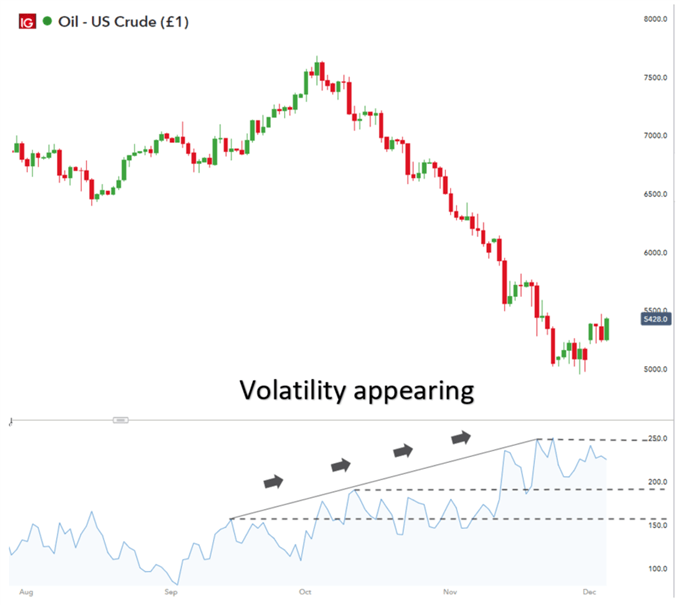Key Takeaways from the Trading Podcast:
- How and when to adjust your position sizing when prices are volatile
- Freeing up your margin by using less capital
- Considering the opportunity cost of existing positions
- Live to trade another day (absorb losses without blowing up your account)

Adapting your approach in this trading environment is key to successful trading
In this week’s episode senior analyst, Tyler Yell, unpacks the recent spate of volatility in the markets and reveals how to tailor your approach to “Survive another day” should the move work against you.
Volatility has been cyclically depressed in recent years, appearing every so often but what we have seen in early 2018, and now toward the end of 2018, appears to be a pattern of volatility. So how should traders change their approach under such volatile conditions?
4 Bear Market Trading Strategies
Reduce position sizing
As volatility increases and price moves become more violent, reduce position sizes. Think of it this way, you can make twice as much money on half of the position in a bear market that exhibits 4 times its usual volatility. Reducing position sizes has the added benefit of keeping you calmer and help you to manage the emotions of trading.
Freeing up margin
An additional benefit stemming from lower position sizes is that you are left with more available margin. Put differently, you are using a lower proportion of your trading account which leaves ample room to take advantage of new trading opportunities. Typically, traders should have sufficient funds in the account to capitalise on volatility strategies such as, bear market rallies on short time frames and divergences that play out successfully.
Opportunity cost
This is probably one of the most overlooked bear market trading strategy as it is essentially a hidden cost. Regardless of the market, you're looking for opportunities with an edge and in a fast-moving, volatile market, the positions that are losing tend to hold an opportunity cost that isn’t worth the potential profit.
By keeping an inventory of new opportunities, you'll be less encouraged to keep losing trades and jump on new opportunities that volatility can take into the green quickly.
Live to trade another day
Keep the long-term in mind. The often-forgotten beauty of bear markets is that every day can present excellent opportunities for those that play both sides of the tape. While it may be exciting to trade large, one trade should never be so crucial that it can put you out of the game completely. James Stanley, who was recently interviewed on the show, sums it up perfectly when he says you should see each trade as Just One of a Thousand Insignificant, Little Trades.
Practical example of volatility seen in WTI Oil

A helpful indicator that traders use to identify volatility is the Average True Range (ATR), which describes how much a market moves, on average, over a specified time(blue line).
Looking at the chart above, you will see that from August to September the ATR hovered around 160 points or less. The first sign of increased volatility surfaced around early to mid October and jumped even further in November. Traders should view the consistently higher volatility in October as a signal to reduce trading sizes. Reducing the trading size has the added benefit of freeing up margin for new trading opportunities. Such an opportunity appeared as WTI turned sharply lower.
The opportunity cost for long traders, in this example, is clear to see. Holding on to a long trade as the market moves lower and lower will increase your margin obligation and prevent you from taking advantage of new (more profitable) trading opportunities.
Adopting these strategies will increase the chances of you living to trade another day during turbulent markets.
Helpful resources:
- If you are just starting out on your trading journey it is essential to understand the basics of Forex trading in our free New to Forex trading guide.
- Jeremy Wagner, Head Forex Trading Instructor, provides a practical approach to trading volatile markets that all traders should be aware of.
- If you are interested in a video example, Chief Currency Strategist, John Kicklighter, had produced an example on how to adopt a more Regimented Trading approach to volatile markets.
- Upward trending markets don’t last forever which is why all traders should be able to identify and trade a bearish reversal.
- Learn how to trade a bearish engulfing pattern.
- At DailyFX we researched over 100,000 live IG Group accounts to find out the secrets of successful traders and published the findings in our Traits of Successful Traders.
If you found this article useful, you should follow our weekly podcasts. Whether you are looking for market analysis, trading education or interviews with well-known industry professionals, we have you covered.
Follow our podcasts on a platform that suits you:
iTunes: https://itunes.apple.com/us/podcast/trading-global-markets-decoded/id1440995971
Stitcher: https://www.stitcher.com/podcast/trading-global-markets-decoded-with-dailyfx
Soundcloud: https://soundcloud.com/user-943631370
Google Play: https://play.google.com/music/listen?u=0#/ps/Iuoq7v7xqjefyqthmypwp3x5aoi




